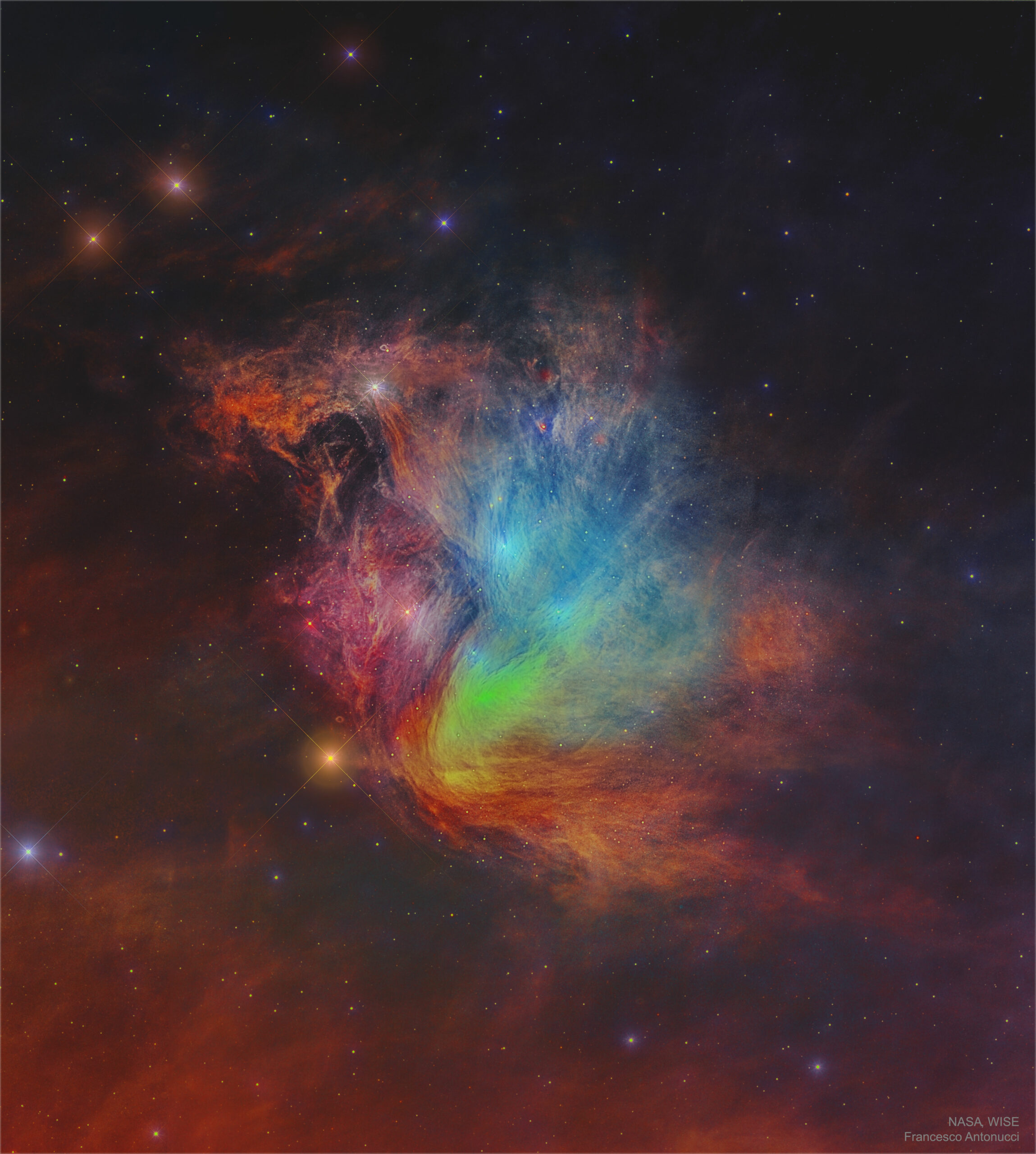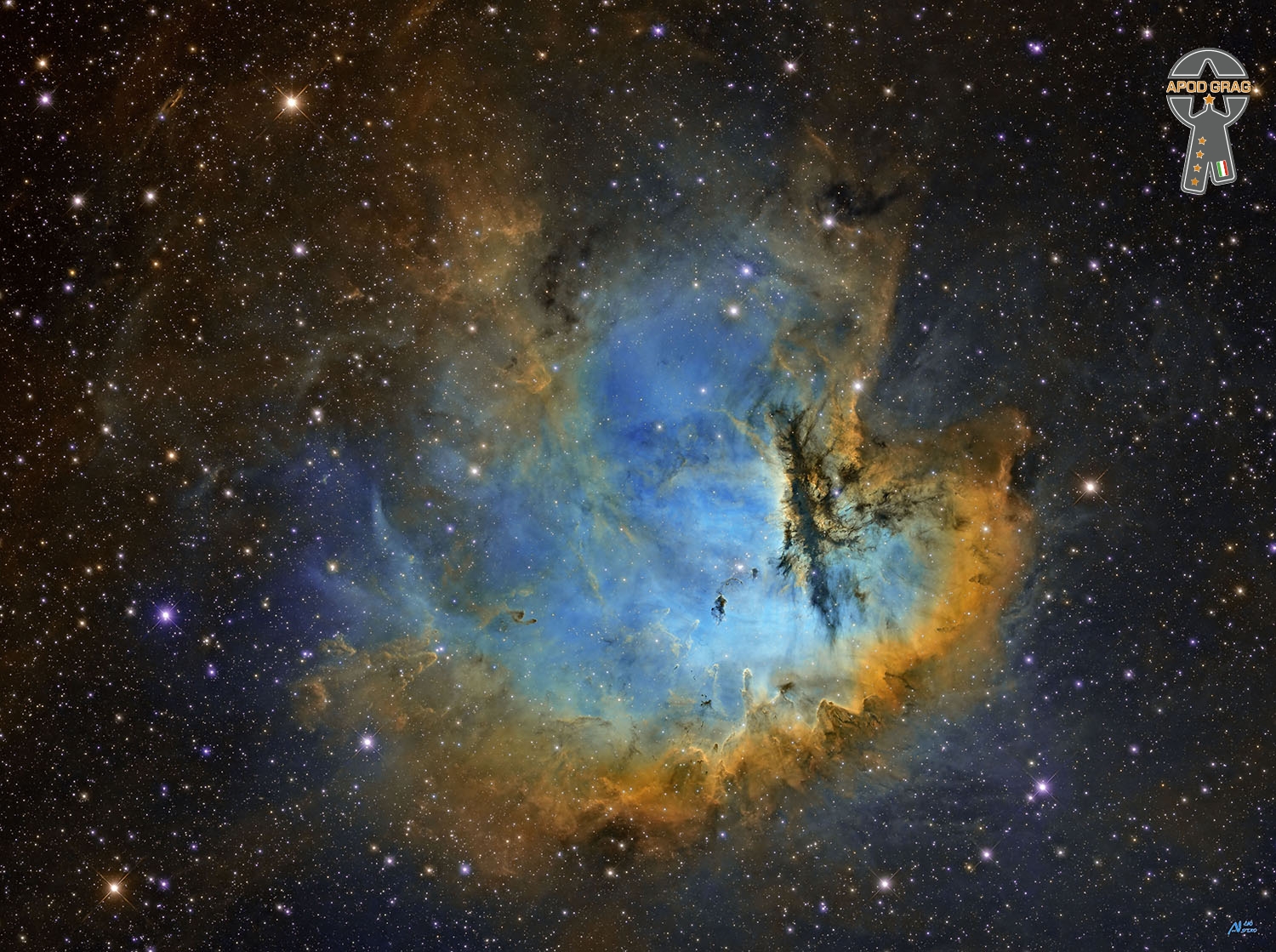Blog
Known for its iconic blue stars, the Pleiades is shown here in infrared light where the surrounding dust outshines the stars. Here three infrared colors have been mapped into visual colors (R=24, G=12, B=4.6 microns). The base images were taken by NASA’s orbiting Wide Field Infrared Survey Explorer (WISE) spacecraft. Cataloged as M45 and nicknamed the Seven Sisters, the Pleiades star cluster is by chance situated in a passing dust cloud. The light and winds from the massive Pleiades stars preferentially repel smaller dust particles, causing the dust to become stratified into filaments, as seen. The featured image spans about 20 light years at the distance of the Pleiades, which lies about 450 light years distant toward the constellation of the Bull (Taurus).

Robert Edward Rogers (February 19, 1940 – March 3, 2013) was an American musician and tenor singer, best known as a member of Motown vocal group the Miracles from 1956 until his death. He was inducted, in 2012, as a member of the Miracles to the Rock and Roll Hall of Fame. In addition to singing, he also contributed to writing some of the Miracles’ songs. Rogers is the grandfather of R&B singer Brandi Williams from the R&B girl group Blaque and is a cousin of fellow Miracles member Claudette Rogers Robinson.
Rogers was the son of Robert and Lois Rogers. He was born in Detroit on February 19, 1940, the same day and in the same Detroit hospital as fellow Miracles member Smokey Robinson, although the two would not meet until 15 years later.
On December 18, 1963, Rogers married Wanda Young of Inkster, Michigan, a member of Motown group the Marvelettes. Together they had a son Robert Rogers III and a daughter Bobbae. Rogers and Young divorced in 1975 after twelve years of marriage. In 1981, Rogers married Joan Hughes on his forty-first birthday. The wedding ceremony was officiated by the Reverend Cecil Franklin, the older brother of Queen of Soul Aretha Franklin at Detroit’s historic New Bethel Baptist Church. Bobby and Joan had two children together, daughters Gina and Kimberly. In his final years, Rogers divided his residence between his primary dwelling in Southfield, Michigan, a northern suburb of Detroit, and a Beverly Hills, California pied-à-terre.
The 1960 single “Shop Around“, with Smokey Robinson on lead, was Motown’s first number one hit on the R&B singles chart, and the first big hit for the Miracles. The song was also Motown’s first million selling hit single. The Miracles scored many more hits over the years including the #1 classics “Tears Of A Clown”, and “Love Machine”.
In addition to his work in the Miracles, Rogers was a part-time Motown songwriter; his most notable composition, authored with bandmate Smokey Robinson, was The Temptations‘ first hit single, “The Way You Do the Things You Do“. Rogers also co-wrote The Temptations’ 1965 hit “My Baby“, Mary Wells’ hit, “What Love Has Joined Together“, The Contours‘ 1965 hit “First I Look at the Purse“, (later covered by the J. Geils Band), Marvin Gaye’s 1966 Top 40 hit, “One More Heartache” and the Miracles’ own 1964 Top 40 hit, “That’s What Love Is Made Of“, and their 1966 hit, “Going to a Go-Go“. He is also noted for doing co-lead vocals on the Miracles’ 1962 Top 10 smash, “You’ve Really Got a Hold on Me“, and singing lead on the group’s 1964 song, “You’re So Fine And Sweet”. Bobby was also reputed to be the group’s best dancer, and was responsible for many of the Miracles’ onstage routines, until the arrival of famed Motown choreographer Cholly Atkins.
more...Louis “Kid Shots” Madison (19 February 1899, New Orleans – September 1948, New Orleans) was an American jazz cornetist.
Madison was born in New Orleans on 19 February 1899. He studied cornet under David Jones, Louis Dumaine, and Joe Howard. In 1915, he was the drummer in the Colored Waif’s Home band with Louis Armstrong. In 1923, he played second cornet with the Tuxedo Brass Band. During the 1930s, he played with the WPA brass band. In the 1940s, he played with the New Orleans Eureka Brass Band.
In January 1948, Madison suffered from a stroke and died eight months later.
more...
William “Smokey” Robinson Jr. (born February 19, 1940) is an American singer, songwriter, record producer, and former record executive director. He was the founder and front man of the Motown vocal group the Miracles, for which he was also chief songwriter and producer.He led the group from its 1955 origins as “the Five Chimes” until 1972, when he announced his retirement from the group to focus on his role as Motown’s vice president. However, Robinson returned to the music industry as a solo artist the following year. Robinson left Motown Records in 1990, following the sale of the company two years earlier.
Robinson was inducted into the Rock and Roll Hall of Fame in 1987 and was awarded the 2016 Library of Congress Gershwin Prize for his lifetime contributions to popular music.In 2022, he was inducted into the Black Music & Entertainment Walk of Fame.
William Robinson Jr. was born to an African-American father and a mother of African-American and French descent into a poor family in the North End area of Detroit, Michigan.Robinson’s ancestry is also part Nigerian, Scandinavian, Portuguese, and Cherokee. His uncle Claude gave him the nickname “Smokey Joe” when he was a child.
more...A mere 56 million light-years distant toward the southern constellation Fornax, NGC 1365 is an enormous barred spiral galaxy about 200,000 light-years in diameter. That’s twice the size of our own barred spiral Milky Way. This sharp image from the James Webb Space Telescope‘s Mid-Infrared Instrument (MIRI) reveals stunning details of this magnificent spiral in infrared light. Webb’s field of view stretches about 60,000 light-years across NGC 1365, exploring the galaxy’s core and bright newborn star clusters. The intricate network of dusty filaments and bubbles is created by young stars along spiral arms winding from the galaxy’s central bar. Astronomers suspect the gravity field of NGC 1365’s bar plays a crucial role in the galaxy’s evolution, funneling gas and dust into a star-forming maelstrom and ultimately feeding material into the active galaxy’s central, supermassive black hole.

Veronica “Randy” Crawford (born February 18, 1952 Macon, GA) is an American jazz and R&B singer. She has been more successful in Europe than in the United States, where she has not entered the Billboard Hot 100 as a solo artist. However, she has appeared on the Hot 100 singles chart twice. The first time was in 1979 as a guest vocalist on The Crusaders‘ top-40 hit “Street Life“. She also dueted with Rick Springfield on the song “Taxi Dancing”, which hit number 59 as the B-side of Springfield’s hit “Bop Til You Drop”. She has had five top-20 hits in the UK, including her 1980 number-two hit, “One Day I’ll Fly Away“, as well as six UK top-10 albums. Despite her American nationality, she won Best British Female Solo Artist in recognition of her popularity in the UK at the 1982 Brit Awards. In the late 2000s, she received her first two Grammy Award nominations.
more...
Sidney Thomas “Tommy” Boyce (September 29, 1939 – November 23, 1994) and Bobby Hart (born Robert Luke Harshman; February 18, 1939) were a American duo of singer-songwriters. In addition to three top-40 hits as artists, the duo is well known for its songwriting for The Monkees.
Hart’s father was a church minister and he himself served in the Army after leaving high school. Upon discharge, he travelled to Los Angeles seeking a career as a singer. Boyce was separately pursuing a career as a songwriter. After being rejected numerous times, Boyce took his father’s suggestion to write a song called “Be My Guest” for rock and roll star Fats Domino. He waited six hours at Domino’s hotel room to present him with the demo, and got Domino to promise to listen to the song. The song hit No. 8 in the US and No. 11 in the UK, becoming Domino’s biggest hit there in several years, and sold over a million copies.Boyce also found success as the co-writer, with Curtis Lee, of Lee’s 1961 hits “Pretty Little Angel Eyes” and “Under the Moon of Love“.
more...Bobby Taylor & the Vancouvers were a Canadian soul band from Vancouver, British Columbia, Canada. The group recorded for the Gordy Records division of Motown Records in 1968, where they had a top 30 hit single, “Does Your Mama Know About Me”. As a producer and solo artist, Bobby Taylor contributed to several other soul recordings, both inside and outside of Motown. Taylor is most notable for discovering and mentoring The Jackson 5. Tommy Chong was a member of Bobby Taylor & the Vancouvers before he became famous as a comedian.
Bobby Taylor, born Robert Edward Taylor on February 18, 1934, in Washington, D.C., was raised in Washington. As a young man, he moved to New York City and sang in doo-wop groups with singers who later joined successful acts such as Frankie Lymon & the Teenagers and Little Anthony and the Imperials. In 1958 he began his music career as a member of The Four Pharaohs, who released a few locally-selling recordings in the Columbus, Ohio area.
more...Irma Thomas (née Lee; born February 18, 1941) is an American singer from New Orleans. She is known as the “Soul Queen of New Orleans”.
Thomas is a contemporary of Aretha Franklin and Etta James, but never experienced their level of commercial success. In 2007, she won the Grammy Award for Best Contemporary Blues Album for After the Rain, her first Grammy in a career spanning over 50 years.
Born Irma Lee, in Ponchatoula, Louisiana, United States, she was the daughter of Percy Lee, a steel chipper, and Vader Lee, who worked as a maid. As a teenager, she sang with a Baptist church choir. She auditioned for Specialty Records at the age of 13. By the time she was 19, she had been married twice and had four children. Keeping her second ex-husband’s surname, she worked as a waitress in New Orleans, occasionally singing with bandleader Tommy Ridgley, who helped her land a record deal with the local Ronlabel. Her first single, “Don’t Mess with My Man”, was released in late 1959, and reached number 22 on the US Billboard R&B chart.
She then began recording on the Minit label, working with songwriter and producer Allen Toussaint on songs including “It’s Raining” and “Ruler of My Heart”, which was later reinterpreted by Otis Redding as “Pain in My Heart”. Imperial Records acquired Minit in 1963, and a string of successful releases followed. These included “Wish Someone Would Care”, her biggest national hit; its B-side “Breakaway“, written by Jackie DeShannon and Sharon Sheely (later covered by Tracey Ullman, among others).
more...NGC 281 is a HII region located about 10 000 light-years from Earth in the constellation Cassiopeia. With a diameter of about 100 light-years, it is part of the Perseus Arm. It includes or is close to the open cluster IC 1590, the double star HD 5005 and several Bok globules. It is visible through an amateur telescope in areas where the night sky is sufficiently dark. It is sometimes unofficially called the Pacman Nebula because of its coincidental resemblance to the eponymous hero of the arcade game Pac-Man.
This emission nebula was discovered by the American astronomer Edward Barnard in 1881.
Photo taken in Normandy France from 05/08 to 17/12/22.

Jeremy Webster “Fred” Frith (born 17 February 1949) is an English multi-instrumentalist, composer, and improviser.
Probably best known for his guitar work, Frith first came to attention as one of the founding members of the English avant-rock group Henry Cow. He was also a member of the groups Art Bears, Massacre, and Skeleton Crew. He has collaborated with a number of prominent musicians, including Robert Wyatt, Derek Bailey, the Residents, Lol Coxhill, John Zorn, Brian Eno, Mike Patton, Lars Hollmer, Bill Laswell, Iva Bittová, Jad Fair, Kramer, the ARTE Quartett, and Bob Ostertag. He has also composed several long works, including Traffic Continues (1996, performed 1998 by Frith and Ensemble Modern) and Freedom in Fragments (1993, performed 1999 by Rova Saxophone Quartet). Frith produces most of his own music, and has also produced many albums by other musicians, including Curlew, the Muffins, Etron Fou Leloublan, and Orthotonics.
He is the subject of Nicolas Humbert and Werner Penzel’s 1990 documentary Step Across the Border. Frith also appears in the Canadian documentary Act of God, which is about the metaphysical effects of being struck by lightning. He has contributed to a number of music publications, including New Musical Expressand Trouser Press, and has conducted improvising workshops across the world. His career spans over four decades and he appears on over 400 albums, and he still performs actively throughout the world.
Frith was awarded the 2008 Demetrio Stratos Prize for his career achievements in experimental music. The prize was established in 2005 in honour of experimental vocalist Demetrio Stratos, of the Italian group Area, who died in 1979. In 2010 Frith received an honorary doctorate from the University of Huddersfield in West Yorkshire, England, in recognition of his contribution to music. Frith was Professor of Composition in the Music Department at Mills College in Oakland, California, until his retirement in 2018. He is the brother of Simon Frith, a music critic and sociologist, and Chris Frith, a psychologist at University College London.
more...(born. February 17, 1937, Chicago). He is best known as baritone, background vocals, with The Dells from -1952–2012. The Dells were an American R&B vocal group. Formed in high school in 1952 by founding members Marvin Junior, Verne Allison, Johnny Funches, Chuck Barksdale, and Mickey and Lucius McGill, under the name the El-Rays, they released their first recording in 1954, and two years later, had their first R&B hit with “Oh What a Night”. After disbanding due to a near-fatal car crash in 1958, the band reformed in 1960 with Funches being replaced by Johnny Carter. This lineup remained together until Carter’s 2009 death. The Dells were inducted to the Rock and Roll Hall of Fame and the Vocal Group Hall of Fame in 2004. The vocal group performed until illness forced longtime lead singer Marvin Junior and bass vocalist Chuck Barksdale into retirement, ending the group’s 60-year run.
The Dells grew up in Harvey, Illinois and began singing together while attending Thornton Township High School. Forming in 1952 under the name the El-Rays, the group initially consisted of Marvin Junior, Mickey McGill, Lucius McGill, Verne Allison, Chuck Barksdale, and Johnny Funches. Lucius soon left the group and the remaining quintet signed with Checker Records, releasing their first single, “Darling I Know,” which flopped.
more...There are two parts to a Fandangos de Huelva, including the estribillo, a rhythmic chordal refrain played on the guitar with or without singing, and the coplas. These two parts alternate, similar to the chorus and verse in a folk song: The compás for the Fandangos de Huelva is a six count pattern with accents on the third and fifth beats.
Each copla (verse) of the Fandangos de Huelva contains six sets of twelve counts, and dancers usually perform several verses of the song, or trade off performing a verse with another dancer. In a performance, the guitarist plays two or four sets of estribillos before each copla. The singer may also sing the estribillo before the first copla. When performed in the traditional, regional style, steps are characterized by beautiful leg gestures, flicks of the feet, jota steps and jumps, escuela bolera steps and patterns, a small amount of taconeo/zapateado, castanets, and a distinctive arched line in the back of the dancer – torcido – which produces a spiraling effect. The dance is also often performed aflamencada, in a flamenco style that includes footwork, flamenco marking steps and cues, and llamadas and remates that are similar to those found in Bulerías.
The typical scenario for a traditional Fandangos de Huelva dance (performed by soloists or in groups) is as follows:
-
Entrance/entrada
-
Danced to a musical (with or without cante) estribillo
-
-
1st copla
-
Each verse contains six sets of twelve count phrases, performed with or without castanets, and includes traditional regional or flamenco steps and phrases
-
-
Estribillo transition
-
Two to four sets of twelve count phrases are performed to the estribillo music, acting as transitions between the coplas (verses). These transitions allow dancers to enter or exit the stage.
-
-
Arrimaté
-
A traditional cierre (closing/ending) for cante and baile por Fandangos de Huelva
-
Three large galaxies, ellipticals and a spiral blue,
Dominant and grand, each 150,000 light-years wide,
But it was the overlapping pair that caught my view,
Cataloged as NGC 3314, a sight I cannot hide.
Abell 1060, the Hydra galaxy cluster’s name,
One of three large galaxy clusters close to our Milky Way,
A universe bound by gravity, a celestial game,
Where clusters align over larger scales, I cannot sway.
At a distance of 100 million light-years, this snapshot’s size,
1.3 million light-years across, a cosmic delight,
A momentary glimpse into the universe’s guise,
But even this shall fade, and be nevermore in sight.

Otis Blackwell (February 16, 1931 – May 6, 2002) was an American songwriter whose work influenced rock and roll. His compositions include “Fever” (recorded by Little Willie John), “Great Balls of Fire” and “Breathless” (recorded by Jerry Lee Lewis), “Don’t Be Cruel“, “All Shook Up” and “Return to Sender” (with Winfield Scott; recorded by Elvis Presley), and “Handy Man” (recorded by Jimmy Jones).
Blackwell was born in Brooklyn, New York. He learned to play the piano as a child and grew up listening to both R&B and country music. His first success was winning a local talent contest (“Amateur Night”) at the Apollo Theater in Harlem in 1952. This led to a recording contract with RCA and then with Jay-Dee. His first release was his own composition “Daddy Rolling Stone“, which became a favorite in Jamaica, where it was recorded by Derek Martin. The song later became part of the Who‘s mod repertoire.
more...More Posts
- Eddie Lockjaw Davis
- World Music Samba Touré
- Daily Roots Sly & the Revolutionaries
- Kurt Vonnegut Dancing
- Cosmo NGC 2736
- Frédéric Chopin
- Burning Spear
- Harry Belafonte
- Ralph Towner
- SAVE UKRAINE World Music DakhaBrakha
- Daily Roots The Upsetters
- Mardi Gras Weekend 2025
- Remembering Wounded Knee 1973
- Echoes of Freedom Mother Teresa
- Happy Losar 2025
- Economic Boycott February 28th
- Temple Israel Shabbat Service
- Cosmo NGC 2237
- Brian Jones
- John Fahey